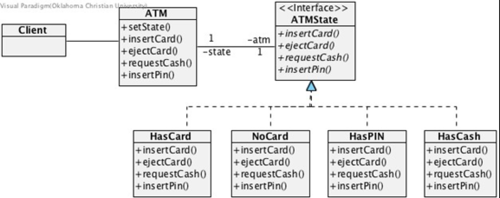Python 中的状态模式
我在用 Python 实现状态设计模式时遇到了一些问题。
我是 Python 的新手,并编写了一些代码来尝试回答提出给我的这个问题:
为一个简单的 ATM 编写代码,允许用户插入他们的卡、输入他们的 PIN、请求现金和弹出卡。将以下对象模型用于显示状态模式使用的系统。您需要确定每个操作要更改为什么状态。
请参阅下面的 UML 图以获取更多信息:

下面是我的尝试...
import re
class AtmState(object):
name = "ready"
allowed = []
def switch(self, state):
""" Switch to new state """
if state.name in self.allowed:
# print("Current {} => switched to new state {}.".format(self, state.name))
self.__class__=state
# These print statements show how you switch between states.
# else:
# print("Current {} => switched to {} not possible.".format(self, state.name))
def getState(self):
print("The current state is {}".format(self.state))
def __str__(self):
return self.name
def __repr__(self):
return r"The ATM is in a {} state.".format(self.state)
def insertCard(self, card):
# Set messages for card format and inserted
wrong_format = "Please insert your card in the following format: XXXX-XXXX-XXXX-XXXX."
card_inserted = "Card Inserted: {}"
card_pattern='^([0-9]{4})(-?|\s)([0-9]{4})(-?|\s)([0-9]{4})(-?|\s)([0-9]{4})$'
pattern = re.compile(card_pattern)
if pattern.match(card) and str(self.state) in ["insert", "ready", "no card"]:
self.state.switch(HasCard)
print(card_inserted.format(card))
self.state.switch(HasPin)
elif pattern.match(card)==False and str(self.state) ["insert", "ready", "no card"]:
print(wrong_format)
elif str(self.state) in ["enter_pin", "withdraw"]:
print("Card already inserted")
elif str(self.state) in ["no card"]:
print("Error: No Card Inserted. Please insert card.")
对我来说最大的困惑是如何使用类来实现它?我能够获得正确的逻辑,但我正在努力使用状态设计模式进行实现。
任何指导将不胜感激。
 慕无忌1623718
慕无忌16237182回答
-

噜噜哒
这是您问题的简化版本的python3中的快速而肮脏的实现。State 是一个抽象类,使用(Mickeal 描述的 abc 包)充当接口(派生类必须实现抽象方法)。实际状态接收请求并实现函数并执行状态转换这就是为什么我将 atm 对象作为参数方法传递import abcclass State(object,metaclass = abc.ABCMeta): @abc.abstractmethod def eject(self, atm): raise NotImplementedError('') @abc.abstractmethod def insert(self, atm): raise NotImplementedError('')class NoCard(State): def eject(self, atm): print('Error : no card') def insert(self, atm): print('ok') atm.state = HasCard()class HasCard(State): def eject(self, atm): print('ok') atm.state = NoCard() def insert(self, atm): print('Error : card already present')class ATM: def __init__(self): self.state = NoCard() def insert(self): self.state.insert(self) def eject(self): self.state.eject(self)if __name__ == "__main__": atm = ATM() atm.eject() # default state is no card error no card atm.insert() # ok state is has card atm.insert() # error card already in atm.eject() # ok state become no card atm.eject() # error no card -

ITMISS
Atm不应该从AtmState但从无(或从object,无所谓)继承。它应该只包含:state变量、change改变状态AtmState的方法以及调用当前同名方法的方法中的每个方法,并state带有一个名为例如atm包含调用Atm对象(上下文)的附加参数。AtmState应该只包含没有实现的方法(并且没有变量),因为它是原始模式中的接口。对于 Python,您应该使其成为具有抽象方法的抽象类,请参阅模块abc如何做到这一点。派生自的具体类AtmState现在应该实现这些方法。通常每个类只需要一两个方法,其余的应该只打印一个错误。例如,该NoCard.ejectCard()方法仅显示无法弹出不存在的卡的错误。通过从方法之一调用atm.change()方法(atm是由Atm类添加的附加参数),可以在状态之间切换。
 随时随地看视频慕课网APP
随时随地看视频慕课网APP
相关分类


 Python
Python